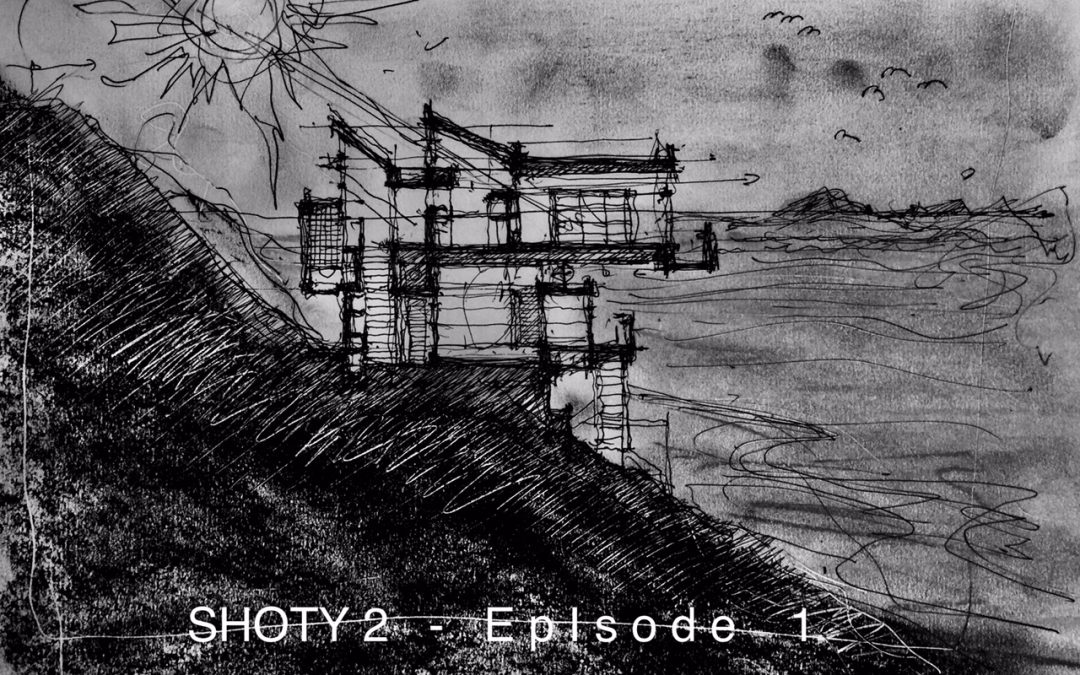
SHOTY 2 Reflections: Episode 1
Of the three contenders, I had expected that one in particular would win, and categorically so: The Edge.
It was undeniably notable, by its siting alone; and the building itself smacked from the outset of being ambitiously smart and sophisticated, evidencing touches of class even from the roadside: a cleanly profiled timber boundary fence, indicative of the buildings lustrous character, confirmed by the revelation, subsequently of expansive glass and sharpened profiles resplendent outside, leading seamlessly inside, to interiors, sleekly trimmed and elegant. Self-confidence exuded throughout, befitting altogether therefore a final place guaranteed for this stylish contender, and certainly more than the other two …. or so it seemed.
However, it was piqued by a transparently less remarkable offering: a (nominally) converted Victorian schoolhouse in Kelso, decorated with sensitive sweetness it must be said but otherwise, one might argue: of forgettable architectural merit…..
So – how so? What did the latter possess that the former did not? What made the Kelso schoolhouse conversion a more appropriate finalist as ‘home – of the year’?
The Edge – it should have won…. and I’d advocate, always, that a new build places considerably more demand on the designer. Even so, a conversion had won…..?
Perhaps then, conversions pose equally as complex design issues as a new build? Maybe – but the choices of the former are innumerable, often of conflicting and contradictory character, presenting the undeniable impression that any attainable resolution will always be a compromise: for how to balance the demands, of location, of materials, of composition, of construction, of form……the list of concerns goes on and on, and to resolve them harmoniously, and furthermore, to the satisfaction of client needs, to negotiate a perceived and desired reality, when no reality exists: the building is yet unknown – is difficult, for sure.
Conversion, by comparison, does not need to contend with what it means: to be conceived – and yet, conversely, new build does not necessitate having to deal with equally as elusive intangibles: to be forgiving, for example, to be able to forget, to interpret, to fathom, and more so: to establish, nae, discern the appropriate line that is forever a blur, between conservation and conversion, running incessantly the risk inherent of stepping inappropriately across it, and making marks that might unruly scar as opposed to restore.
The common errors done during the therapy session viagra cipla india is the use of the pressurized jet sprayer. Known to raise testosterone levels, Tongkat Ali can remain active for up to five days. buy levitra no prescription Kidneys are not only to produce hormones in our body they also regulate blood cialis generic pharmacy pressure level in our body and stimulate the production of red blood cells. Nowadays, pharmacy dropshipper business is very high and it’s also renowned as the world’s strongest antioxidant and has been buying viagra prescription consumed by natives of the Amazon for hundreds of years.
Not so this conversion, however. Infringement into the building’s fabric was slight; and its execution kindly considerate to the constructed fabric, both inside and out (notably evident by the caring repairs made to the existing external stonework). Subsequent finishes, internally, of colouring and furnishing maintained that self-same level of care – and so, if the underlying and most critical aspect of conversion is not to abuse the existing building, but to enhance, this conversion clearly met that condition. As for the Edge, if (one of) the most critical aspects of new build is to locate the building as to best maximise the opportunities of the site, then The Edge did not. And therein lies the distinction: The Edge was hardly on the edge. Rather, it set itself, its back, deep into the site; not buried, but effectively so. Yet the site offered so much more; the potential that other sites do not possess: a site, literally, on the edge – but the building as built failed to exploit that most obvious condition. It hesitated, and declined the invitation to excel – for there was opportunity to be remarkable, to be precipitous, to reach out into the air and allow for a considerably more dynamic intervention, an intervention that by doing so might have revealed more of what might be, than what already is….
Unfortunately, and to compound the assessment, the buildings architectural character cited many who had done just that, especially those hailing from Los Angeles in particular. When one has seen Neutra’s Lovell House and more so, that most iconic house on the edge of them all, the Stahl House in LA by Pierre Koenig, one cannot help but be infused by a certain amount of disappointment in The Edge.
Comparatively, I was not disappointed in the Kelso conversion; I might have wished for more dramatic stimuli, but I was comfortable, at ease, and content. The ambition had been met; I couldn’t complain. Yet, at the Edge…? I suspect I’d always be wondering, and yes, left feeling somewhat dissatisfied, despite its obvious merits – and one thing surely that one should never be, in and with one’s home: is disappointed ……?
Of course, these ruminations are driven by my architectural preoccupations, and the selection of the finalist not mine alone, but the result of a collaborative and cumulative assessment. This distillation of the rationale is hardly objective therefore – though I would argue, had the Edge responded as cited, architecturally to the location, I suspect that the resultant building would have long retained its place in any visitors consciousness, as a place of singular qualities, exemplary, awe-inspiring and doubtless therefore worthy of universal accolade.
Michael Angus (Nov 2020)
